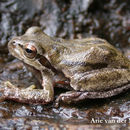Description
(
englanti
)
tarjonnut AmphibiaWeb articles
Small tree frog, usually 38-40mm snout-vent length. Dark stripe on the flanks, starting at the nostril, through the eye and breaking up into spots halfway along the flanks. The head is broader than long, and the snout is shorter than in Hyla arborea. Adhesive discs on all digits. The skin is more granular than in Hyla arborea and Hyla meridionalis. Color and pattern variable and under physiological control. Color can be greenish, olive or gray, usually with dark green or gray spots. Dark bands are usually visible on the outside of the hind legs. Venter is whitish. The pupils are horizontal. The tympanum is clearly visible. (Noellert and Noellert 1992)
- tekijä
- Arie van der Meijden
Distribution and Habitat
(
englanti
)
tarjonnut AmphibiaWeb articles
Hyla sarda is present on the following Mediterranean islands: Corsica, Elba, Cavallo, Sardinia, Maddalena, Caprera and San Pietro. Possibly also occurs on Spargi, San Stefano, Guardinelli, and Santa Maria.Hyla sarda lives in the vicinity of pools, ponds, creeks and streams, usually in woody areas. In inhabited areas they can be found in gardens and in wall cracks, as long as there is water nearby. For reproduction sites Hyla sarda prefers natural springs and cisterns. Hyla sarda is relatively heat tolerant and is tolerant of higher saline concentrations of its breeding waters than Hyla arborea and Hyla meridionalis.
- tekijä
- Arie van der Meijden
Life History, Abundance, Activity, and Special Behaviors
(
englanti
)
tarjonnut AmphibiaWeb articles
The life history of Hyla sarda is relatively unknown. This can be attributed to its isolated island distribution, and to the fact that this tree frog was considered a subspecies of Hyla arborea until 1983. The species is active during twilight and night. The frogs spend the hot hours of the day in shady retreats. The nightly wanderings can be as far as 500m. The call is similar to that of Hyla arborea.
- tekijä
- Arie van der Meijden
Life History, Abundance, Activity, and Special Behaviors
(
englanti
)
tarjonnut AmphibiaWeb articles
A potential danger to this species comes from its isolated island distribution. It has been studied relatively little and therefore there is insufficient data to make any statements about the status of Hyla sarda.
- tekijä
- Arie van der Meijden
Relation to Humans
(
englanti
)
tarjonnut AmphibiaWeb articles
Inhabits gardens and retreats into cracks in walls.
- tekijä
- Arie van der Meijden

